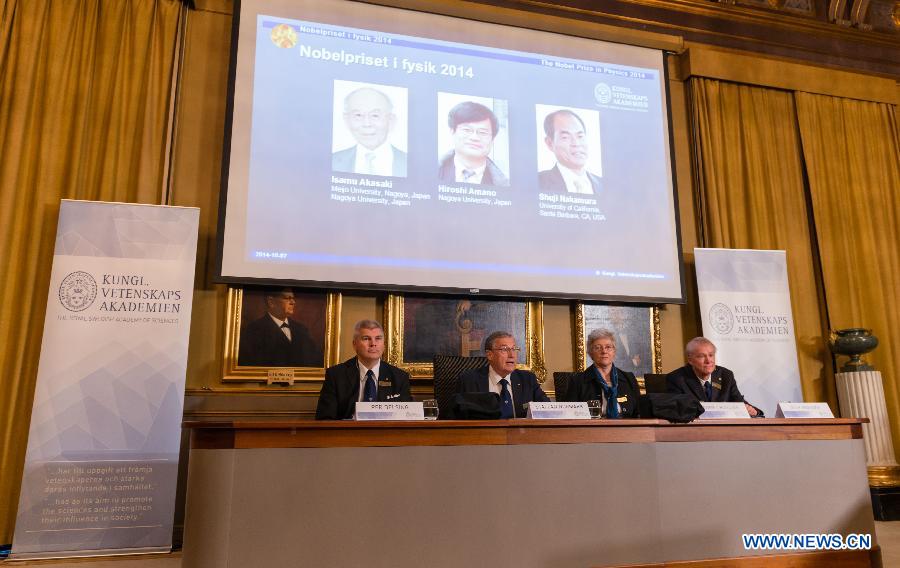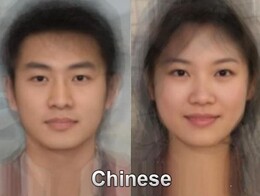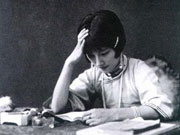 |
| Staffan Normark (2nd L), permanent secretary of the Royal Swedish Academy of Sciences, announces the winners of the 2014 Nobel Prize in Physics, at the Royal Swedish Academy of Sciences in Stockholm, capital of Sweden, Oct. 7, 2014. Isamu Akasaki and Hiroshi Amano of Japan and Japanese-born U.S. scientist Shuji Nakamura won the 2014 Nobel Prize in Physics for their invention of blue light-emitting diodes, a new energy efficient and environmentally friendly light source, the award-giving body announced Tuesday. (Xinhua/Shi Tiansheng) |
STOCKHOLM, Oct. 7 -- Three scientists won the 2014 Nobel Prize in Physics for their invention of blue light-emitting diodes (LED), a new energy-efficient and environmentally-friendly light source, the award-giving body announced Tuesday.
The Royal Swedish Academy of Sciences has decided to award the Nobel Prize in Physics for 2014 to Isamu Akasaki and Hiroshi Amano from Japan and Japan-born U.S. scientist Shuji Nakamura.
"With the advent of LED lamps we now have more long-lasting and more efficient alternatives to older light sources," the jury said in a statement.
The LED lamp holds great promise for increasing the quality of life for over 1.5 billion people around the world who lack access to electricity grids, as it can be powered by cheap local solar power due to low power requirements, the statement said.
The invention of the blue LED is just 20 years old, "but it has already contributed to create white light in an entirely new manner to the benefit of us all," it added.
Akasaki, born in 1929, is a professor at Meijo University and Distinguished Professor at Nagoya University. Amano, born in 1960, is a professor at Nagoya University.
Nakamura, born in 1954 in Japan, is an American citizen and a professor at University of California.
During an onsite telephone interview, Nakamura said it was really "unbelievable" to be informed of this prize despite being waken up in the midnight.
Commenting on this year's invention, Prof. Olle Inganas from the Nobel Committee of Physics said it was "benefiting of the mankind" and thus in accordance with Alfred Nobel's will.
The statement said, "when the three scientists produced bright blue light beams from their semi-conductors in the early 1990s, they triggered a fundamental transformation of lighting technology. Red and green diodes had been around for a long time but without blue light, white lamps could not be created. Despite considerable efforts, both in the scientific community and in industry, the blue LED had remained a challenge for three decades."
"Their inventions were revolutionary. Incandescent light bulbs lit the 20th century; the 21st century will be lit by LED lamps," commented the statement.
"White LED lamps emit a bright white light, are long-lasting and energy-efficient. They are constantly improved, getting more efficient with higher luminous flux (measured in lumen) per unit electrical input power (measured in watt). The most recent record is just over 300 lm/W, which can be compared to 16 for regular light bulbs and close to 70 for fluorescent lamps," said the statement commenting the efficiency.
"As about one fourth of world electricity consumption is used for lighting purposes, the LEDs contribute to saving the Earth's resources. Materials consumption is also diminished as LEDs last up to 100,000 hours, compared to 1,000 for incandescent bulbs and 10,000 hours for fluorescent lights," said the statement.
This year's prize, 8 million Swedish crown (about 1.12 million U.S. dollars), will be shared equally between the three laureates.

 Chinese netizens fall in love with champion swimmer Ning Zetao
Chinese netizens fall in love with champion swimmer Ning Zetao East China Navy Fleet conducts drill in S China Sea
East China Navy Fleet conducts drill in S China Sea Lingerie show at 2014 Miss China
Lingerie show at 2014 Miss China 'Girlfriend' of Harry Potter visits Chengdu
'Girlfriend' of Harry Potter visits Chengdu China's Pingyao Ancient Town
China's Pingyao Ancient Town Standard faces for each countries
Standard faces for each countries Being with you
Being with you Legendary Chinese women in the early 20th century
Legendary Chinese women in the early 20th century Leading director Wang Quan'an detained for 'buying sex'
Leading director Wang Quan'an detained for 'buying sex' Top 10 Chinese actresses with pretty face
Top 10 Chinese actresses with pretty face
Day|Week|Month